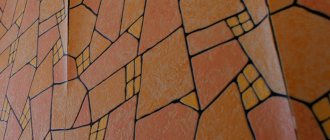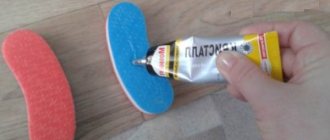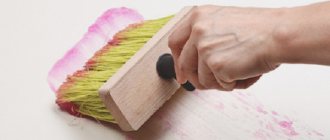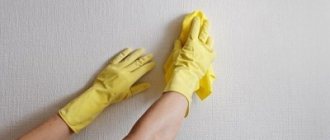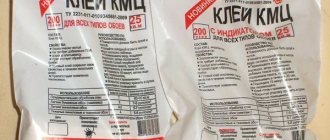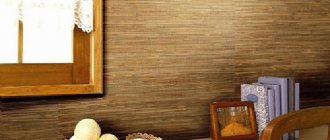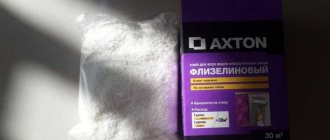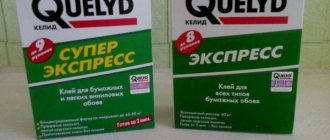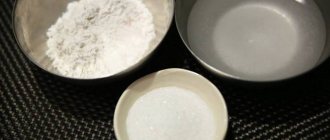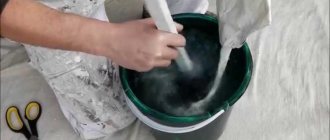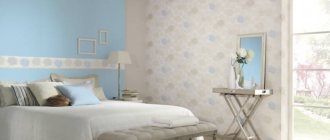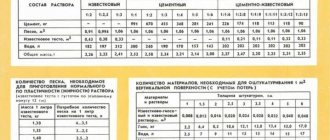Which wallpapers are covered by GOST?
GOST 6810-2002 applies to borders, friezes and the following types of wallpaper:
- paper;
- non-woven;
- textile on paper or non-woven basis;
- vinyl on paper or non-woven base.
Wallpaper made from textile materials without a paper backing, fiberglass or photo wallpaper must comply with other regulatory documents.
All wallpaper sold in Russia must comply with the requirements of GOST 6810-2002
How to choose wallpaper glue ↑
When hiring a team of professional finishers, we fully rely on their experience and knowledge, as well as on the recommendations of relatives and friends. As a result, we most often get beautiful, smooth walls, without flaws, bubbles or wrinkles. Do-it-yourself repairs are a completely different matter. Here you have to decide everything yourself: from choosing rolls to purchasing brushes, rollers and buckets.
Beautiful wallpaper - an opportunity to highlight your style
We encounter the first difficulties when we find ourselves in front of endless shelves with various types of building materials, and many questions immediately arise: which adhesive is better for paper, vinyl or non-woven wallpaper, whether it is possible to save money on its purchase, how expensive offers differ from cheap ones. We warn you right away: it is better not to experiment and stick to high-quality products from well-known manufacturers that have proven themselves exclusively on the positive side.
What are the dangers of using economy class materials or using homemade paste? The consequences can be unpleasant: peeling of the cladding along the joints or in whole pieces, changing the color of the decor, the appearance of stains and streaks on the front wall. Remodeling is a long and labor-intensive task, so saving in this case means buying expensive material.
High-quality glue is the key to a comfortable life without repairs
Thus, if you have started a serious renovation, you should only purchase high-quality products from companies that have been developing and improving them for decades. Don’t forget that special glue is now produced for each category of wallpaper - more on that later.
Types and decorative designs of wallpaper
Depending on the manufacturing features, paper and vinyl wallpapers are divided into several types:
- Embossed ones have a relief surface. To do this, during the manufacturing process they are subjected to chemical, hot, wet or dry embossing. Such wallpaper can have a paper or non-woven backing.
- Profile wallpaper also has a relief surface in the form of a three-dimensional pattern. They are most often made by embossing.
- Velor wallpaper has a fleecy surface. They are made on a paper or non-woven basis, and the characteristic relief is formed with a pile covering.
- Metallized wallpaper is a new generation of finishing materials. They are made on a paper or non-woven basis, and the top layer is aluminum foil or film. Next, the material is embossed, dyed, patinated, blackened or etched with chemical compounds to create a pattern.
- Wallpaper for finishing is made on a paper or non-woven basis; they are intended for painting after pasting.
- Wallpaper decorated with natural substances or textile threads differs from other types of finishing materials. During their manufacture, elements made of organic or inorganic substances are fixed on the front side of the material. This could be, for example, grass, cork, etc.
Based on their decorative design, wallpapers are divided into three types:
- With a printed design without a background.
- With printed design and background.
- With a background without a printed pattern.
The presented division into types is not rigid. Wallpaper can be a combination of the listed types and have other decorative designs, but their quality must meet the requirements of GOST 6810-2002.
Adhesive technical data
CMC glue is made from wood chips processed in a certain way, which allows the output to be a composition that can be used for gluing not only wallpaper, but also concrete, plaster, metal and other materials. CMC is supplied in the form of a white or beige powder, which often has a fibrous content in its structure. The difference from other gluing compositions is the presence of cellulose-glycolic acid in this glue. Thanks to this, it can withstand gluing even particularly heavy canvases.
Important! You should not buy CMC glue that has a yellowish tint. This composition is not of high quality and may contain dangerous impurities.
This composition meets all quality standard requirements. That is why it can be used for wallpapering rooms. The main element of the composition is sodium carboxymethiocellulose of technical type. For several hours it is possible due to the fact that CMC contains hydroxybenzene and potassium-aluminum sulfate. The latter element also plays the role of an antiseptic, like sodium tetraborate and hydroxybenzene.
This glue can reliably protect the wall and the surface of the wallpaper from the appearance of unwanted fungus and mold. The unique composition helps prevent the appearance and reproduction of any insects under the wallpaper. Such properties remain unchanged even if CMC glue is added to cinder block or concrete solutions. In the construction industry, the presented composition is used in the manufacture of bricks of any color. The composition is as correct as possible, so CMC glue is used not only for wallpapering, but also in many construction industries.
Due to its high quality, CMC adhesive can even be included in compositions for laying tiles. This helps to increase strength and adhesive effect.
According to information from manufacturing companies, the technical characteristics of this glue are as follows:
- The share of the base substance is at least 50% of the total mass of the composition.
- Sodium chloride in the entire mass – 21%.
- The substitution index for carboxymethyl groups is 65-85.
- Polymerization index – minimum 670.
- The presence of moisture in dry powder is no more than 16%.
- The solubility of the powder in liquid is 96%.
- The acid-base balance is from 8 to 11.
- The period of complete swelling does not exceed 3 hours.
- The finished 4% solution can be stored for 7 days without loss of quality characteristics.
At the moment, CMC glue of various production is produced - both domestic and foreign. To Russian companies - "Omega", "Politsell", "Karbotsel". Such CMC compositions are cheaper than foreign analogues, but their swelling takes longer. In contrast, imported analogues are completely ready for use within a quarter of an hour after dilution. Instructions for creating the finished composition are available on each package of glue. In a general sense, we can say that the preparation process is not very different from creating a classic adhesive mass. To do this, CMC glue must be poured in the required amount into a pre-measured amount of water at room temperature, mixed thoroughly and left to swell.
Important! The heavier the wallpaper, the thicker the adhesive becomes.
Brands and scope of wallpaper
Based on the resistance of the front side to abrasion and operating characteristics, wallpaper is divided into six classes:
- B-0 – they are water resistant when glued. Undried glue can be removed from their surface during the gluing process with a damp cloth or sponge.
- B-1 – are water resistant during operation. Such wallpaper can be washed with a damp sponge without using detergents.
- M-1 – are resistant to washing. Wallpaper of this brand can be washed using a two percent solution of laundry soap. After this, some types of water-soluble household stains are removed from their surface, but not fats or oils.
- M-2 – highly resistant to washing. They can also be washed using a two percent solution of laundry soap. This removes most water-soluble household stains, including some grease stains.
- M-3 – are resistant to friction. Such wallpaper can be washed using a two percent solution of laundry soap or a cleaning product without bleach. From their surface you can remove not only oils and fats, but also some water-insoluble stains.
- C – resistant to dry abrasion. Such wallpapers are characterized by increased wear resistance.
Taking into account the listed features of wallpaper, GOST 6810-2002 recommends using it for the following purposes:
- M-3 – for toilets and bathrooms of buildings of any type;
- M-1, M-2 – for hallways and inter-apartment corridors of public and residential buildings;
- M-1, B-1, B-0 and C - for any premises of public and residential buildings.
Carboxymethylcellulose: properties and description
Carboxymethylcellulose is a cellulose derivative, which is a weak acid in the form of a light beige, odorless, tasteless, finely crystalline powder. The name is often replaced by the abbreviation KMC. It is an ether of cellulose and glycolic acid.
Preparation and chemical properties
The material is synthesized from non-edible natural raw materials, filled with a concentrated alkaline solution and treated with chloroacetic acid. The resulting impurities of glycolate and sodium chloride are washed off.
CMC is highly soluble in alkalis and water, but insoluble in mineral oils and organic solvents. Dissolving in water, it forms transparent viscous solutions that are plastic and sometimes thixotropic.
Such solutions react well with synthetic and natural polymers, other water-soluble cellulose ethers, salts of alkaline earth and alkali metals, and ammonium.
The sodium salt of carboxymethylcellulose (Na-CMC), an anionic polyelectrolyte, which is a colorless amorphous substance, has received the greatest practical application. It dissolves well in water and binds it, and such solutions are resistant to monovalent salts.
Since one of the main properties of the material is the ability to form a stable and viscous colloidal solution with long-term action, Na-CMC is widely used in various fields of industry. In particular, it is used as a thickener, plasticizer and resorbent:
- To regulate the characteristics of drilling fluids located in aggressive environments in the oil and gas industries and geology;
- For flotation enrichment of sylvinite ores in the mining and chemical industry;
- As a plasticizer for coating mixtures of welding electrodes, an additive to concrete in construction;
- Finishing, sizing and thickening agent in the textile industry and in the manufacture of detergents;
- Thickener for putty mixtures and paints in the paint and varnish industry.
But the most popular use of this material is its use as an adhesive for wallpaper, linoleum and ceramic tiles.
Dimensions of wallpaper, borders and friezes
The dimensions and permissible deviations of wallpaper, borders and friezes can be as follows:
| Parameter | Limit value | Tolerance |
| Wallpaper | ||
| Roll length | Not less than 10.05 m | – 1,5 % |
| Maximum blade length | No more than 42 m | – |
| Usable width | 530 mm | ± 2 mm |
| Edge width on each side of the fabric | 15 mm | ± 1 mm |
| Friezes | ||
| Roll length | Not less than 10.05 m | – 1,5 % |
| Usable width | Not less than 240 mm | ± 2 mm |
| Curbs | ||
| Length of web in roll or strip | At least 5 m | – 1,5 % |
| Usable width | Not less than 12 mm | ± 2 mm |
By agreement with the consumer, it is possible to produce wallpaper with a usable width of 470, 500 or 750 mm.
A mandatory requirement for wallpaper is that its edges must be parallel and straight.
Production Standards
GOST regulates only the production of the main component of the product - carboxymethylcellulose. The actions of GOST 30535-97 “Polymer adhesives” and GOST 7698-93 “Starch” do not apply to the production of CMC glue. The actual KMC glue is produced in accordance with TU 2231-034-07507908, TU 6-55-40-90 and other technical conditions, which may vary depending on the specific manufacturer.
Requirements for materials, production and quality of wallpaper
GOST 6810-2002 lays down the requirements for the raw materials used for the manufacture of wallpaper, the appearance of the finished finishing materials, the designation of the edge cutting line, winding in rolls and packaging.
The quality of wallpaper should be controlled according to the following indicators:
- color fastness to light;
- wallpaper resistance to abrasion;
- the magnitude of the destructive force in a wet state;
- white (for smooth wallpaper with a white background, intended for pasting ceilings);
- stability of the embossing relief (for two-layer paper wallpaper);
- ability to release harmful substances.
GOST 6810-2002 specifies permissible wallpaper defects:
| Type of defect | Tolerance |
| Presence of spots, stripes and contrasting inclusions | Not allowed on the front side |
| Offset drawing elements | No more than 1 mm (for wallpaper made using letterpress printing - no more than 2 mm) |
| Mismatch of the contour of the pattern with the relief of its embossing for embossed wallpaper | No more than 1.5 mm |
| Presence of smudges, stains or unprinted areas of the design | Allowed size 1.5–2.0 mm in greatest dimension |
| The number of smudges, stains or unprinted areas of the design per 1 m of canvas length | No more than 5 pcs. |
| Presence of mechanical damage, tears, folds, wrinkles | Not allowed |
| Non-parallelism of the edges of the canvas | Not allowed |
| The presence of non-glued areas for two-layer paper wallpaper | Not allowed |
| Bonding adjacent layers in a roll | Not allowed |
| Formation of web rolls from component parts | Not allowed |
Description
CMC glue is a product based on the sodium salt of carboxymethylcellulose, obtained by processing cotton cellulose and intended for the preparation of adhesive compositions. It is a finely granulated white powder (the presence of fibers is allowed), containing antiseptic and antifungal additives (borax, hydroxybenzene, potassium aluminum sulfate).
CMC glue is actively used for gluing paper and textile wallpaper, used as an additive in primer, putty, and painting mixtures, and is sometimes present in the component composition of bricks. The adhesive solution has high adhesion to wooden, plastered, concrete surfaces and ensures reliable connection of the material to walls, ceilings, etc.
Labeling requirements
GOST 6810-2002 requires that markings be present on the label of each roll of wallpaper, borders or friezes. It must contain information about the manufacturer, classification, batch and date of manufacture, dimensions, scope of application, characteristics and brief instructions for using the finishing material. Additional information may be included in the labeling. A separate appendix lists the graphic symbols that are used on the label to indicate the properties of the wallpaper.
Wallpaper is marked with these graphic symbols
Application
In general, the instructions for using wallpaper glue are not particularly complicated: strips of wallpaper are coated with it, pressed against the wall and smoothed out.
A number of nuances, however, are useful to know in this case.
- When gluing non-woven fabric, the glue is applied only to the wall.
- If the wallpaper is heavy, it is better to coat both the canvas and the wall with glue. Excess squeezed out at the seams is immediately removed with a sponge.
- Adding 500 grams of PVA per bucket of finished adhesive composition will increase its water resistance and adhesive qualities.
- Wallpaper on a paper backing requires quite a long time to soak it. After you have applied the glue, the strip is folded in half (this operation will prevent the glue from drying) and left for 10-15 minutes.
- Adhesive compositions are successfully used for preliminary priming of walls. In this case, they are diluted to a more liquid consistency.
Before wallpapering, the walls must be primed. On solid substrates you can use liquid wallpaper glue.
Manufacturers
In Russia, CMC is produced by the Polycell, Omega, Karbotsel, and Malva factories. Glue from these manufacturers is cheap.
Foreign manufacturers of CMC glue include:
- Cleo is a French glue that costs 250 rubles per 0.5 kg. Contains fungicidal additives and leaves no residue.
2. Kelid - again a French composition, which began to be actively counterfeited, which is noticeable by the increased consumption of material. The company takes steps to prevent this by regularly changing its packaging design.
3. Methylane - produced in Germany, the company produces a full range of wallpaper adhesives, there are different types and a choice of packaging weights.
It is better to choose CMC glue specifically for wallpapering. It receives good reviews and continues to be popular among craftsmen. It is important not to fall for a fake and choose the right product for specific purposes.
Source (full version): https://gidpokraske.ru/tovary-i-brendy/klej-kmts.html
Important advantages of CMC
Environmentally friendly, proven and affordable glue is very popular in everyday life. It is odorless, easy to prepare and can be stored for a week when many other adhesives must be used within a few hours of mixing.
The main advantages of CMC glue:
- Ecological cleanliness.
- Easy to use.
- Low material consumption.
- No specific smell.
- Compatibility with various substances, including starch, soap.
- The glue does not change color after hardening, even when mixed with other components.
- Prevention of the formation of fungus and mold, protection from insects.
- Durability and reliability.
Due to the special properties of the composition, the glue can connect almost any surface. The absence of mold formation allows it to be used in rooms with high humidity levels. You can safely add the necessary components, because the glue will not change the color or properties.
There is also a minor disadvantage of the glue - the swelling time increases to 2 hours. However, imported compositions do not have this drawback and are prepared in about 15 minutes.
There is always a choice between buying inexpensive domestic glue or expensive foreign ones.
4Classification
4.1 Adhesives, depending on the type of floor covering being glued, are divided into adhesives for: PVC, natural linoleum, textile coverings, rubber coverings, parquet.
The adhesive can be used for one or more types of floor coverings according to the recommendations of both floor coverings and adhesives manufacturers.
4.2 The symbol of the adhesive consists of the name of the classification characteristics (purpose) and the designation of this standard.
Example of product designation when ordering and in other documentation:
— Glue for PVC coating,
GOST R 58211-2018
.
— Glue for natural linoleum,
GOST R58211-2018
.
— Adhesive for textile covering,
GOST R 58211-2018
.
— Glue for rubber coating,
GOST R58211-2018
.
— Glue for parquet,
GOST R 58211-2018
.
Peculiarities
First of all, it is worth emphasizing that there is not just one “Moment” glue; it is a whole galaxy of connecting materials, each intended for a specific task.
Regardless of the specific scope of application, they differ:
- long period of work;
- immunity to water ingress;
- excellent resistance to overheating;
- mechanical strength;
- stability of the formed adhesive seam.
When the adhesive hardens, it does not expand or shrink (which are the main reasons why joints fail prematurely). Even when solvent or machine oil gets into the connection, the performance characteristics are completely preserved. Adhesion between surfaces occurs very quickly, there is no need to take a break from your usual daily activities for a long time.
But its high qualities and associated popularity made Moment a constant target for counterfeiters. No one can guarantee the quality of their products.
As for the unpleasant odor, this is an inevitable feature of almost any adhesive mixture, so there is nothing specific about it.
Where else is CMC glue used?
In addition to carrying out renovation work in homes, this composition is suitable for finishing offices, industrial premises, as well as for production purposes:
- foundry;
- construction, production of finishing and building materials;
- chemical industry;
- mining industry.
The popularity of KMC wallpaper glue does not decrease from year to year; knowing the specifics of working with it, you are protected in advance from possible errors and shortcomings when performing renovations in an apartment.
